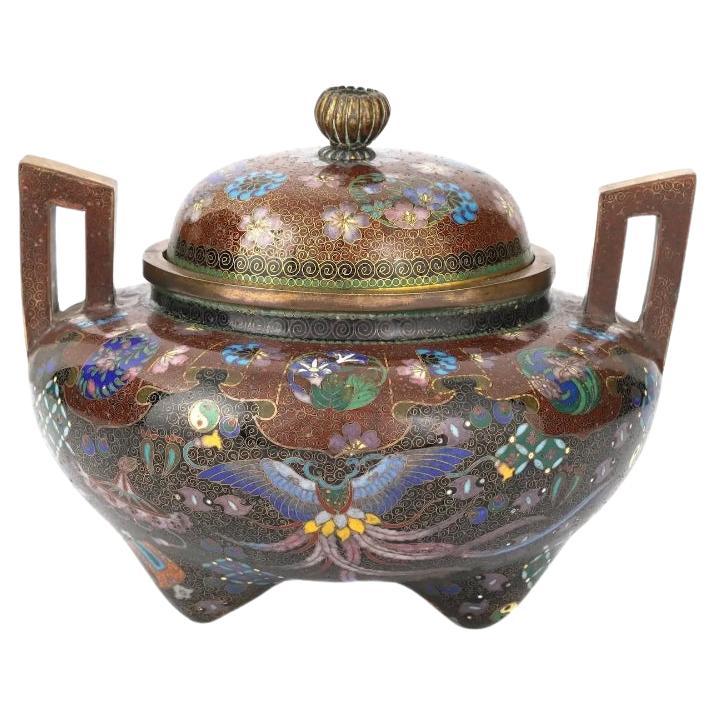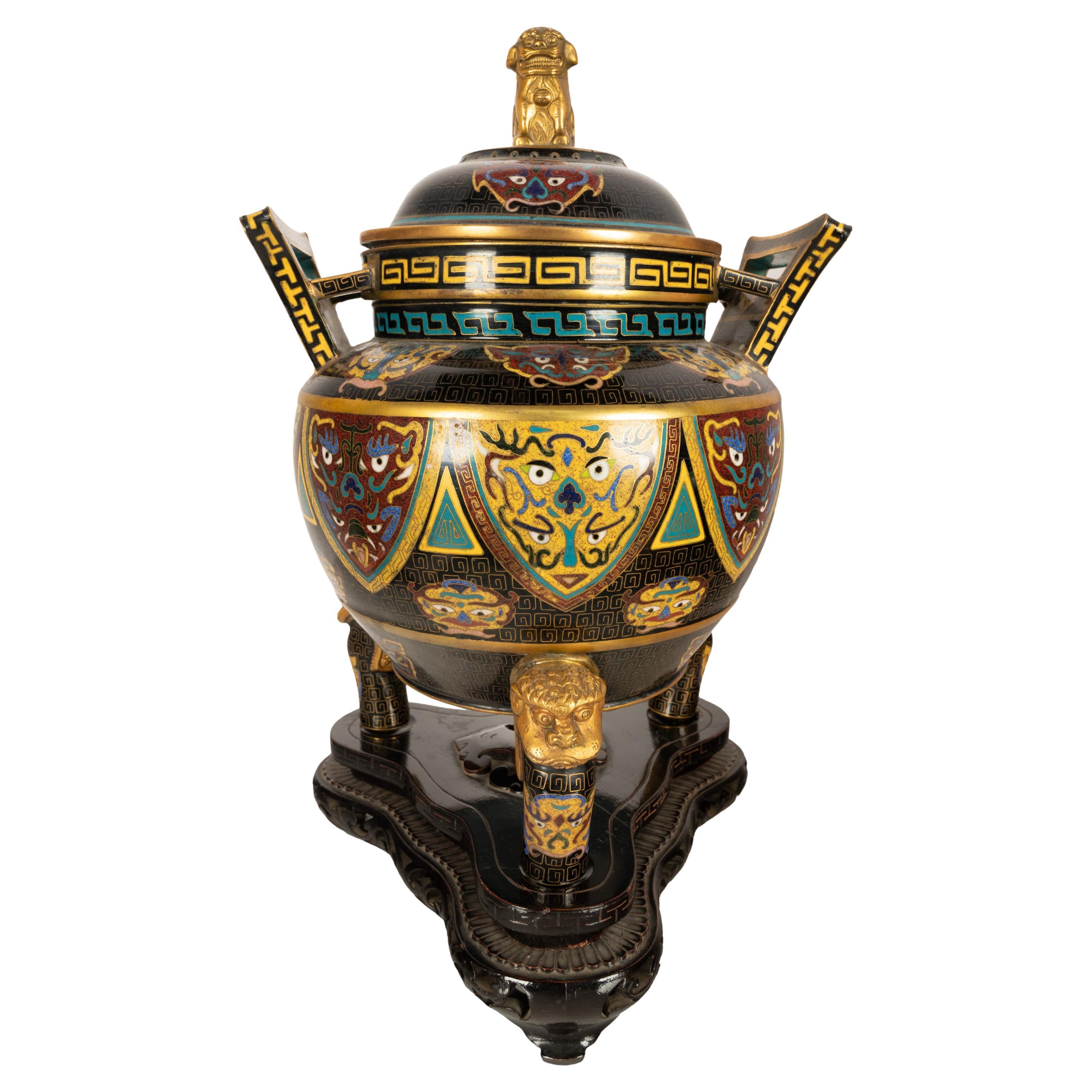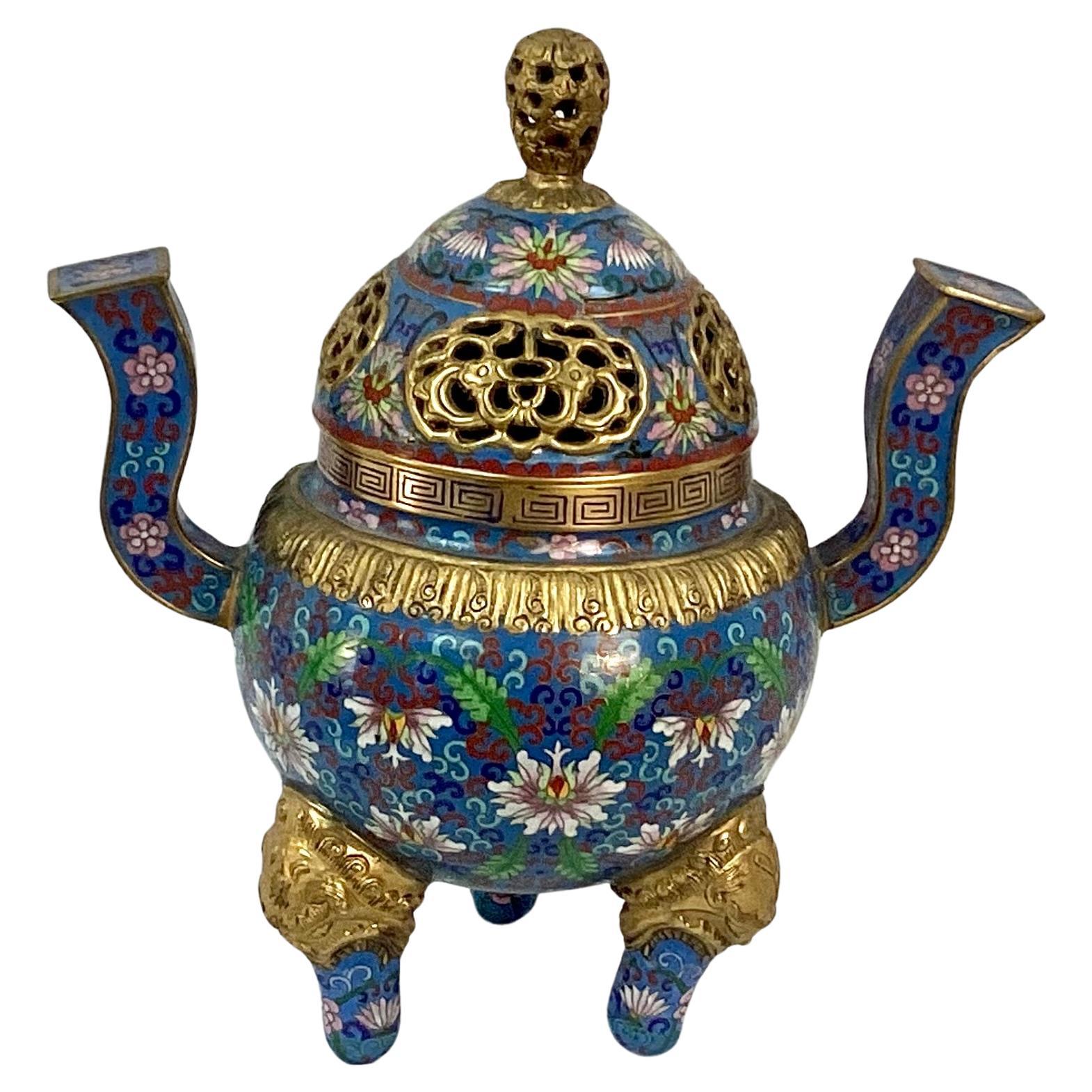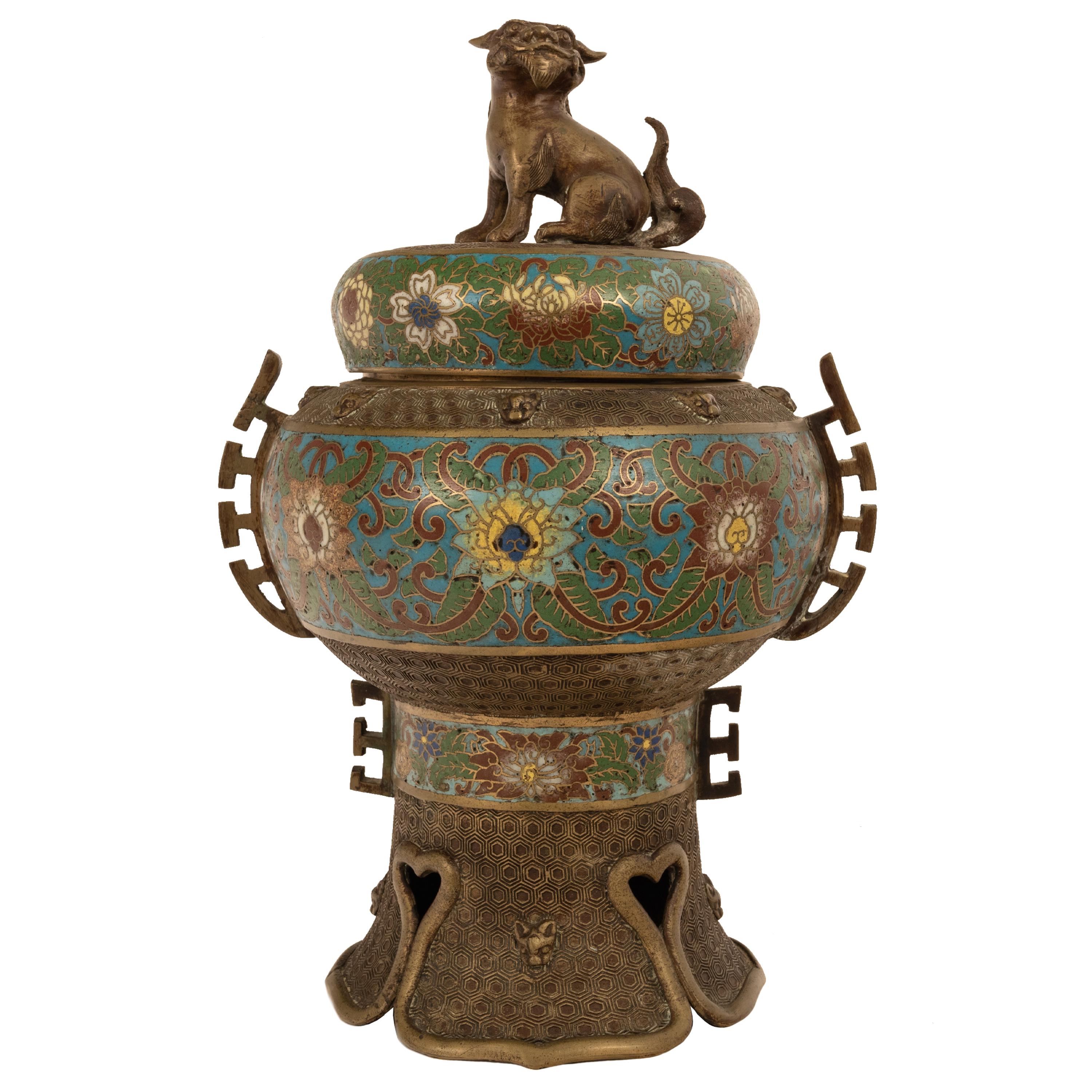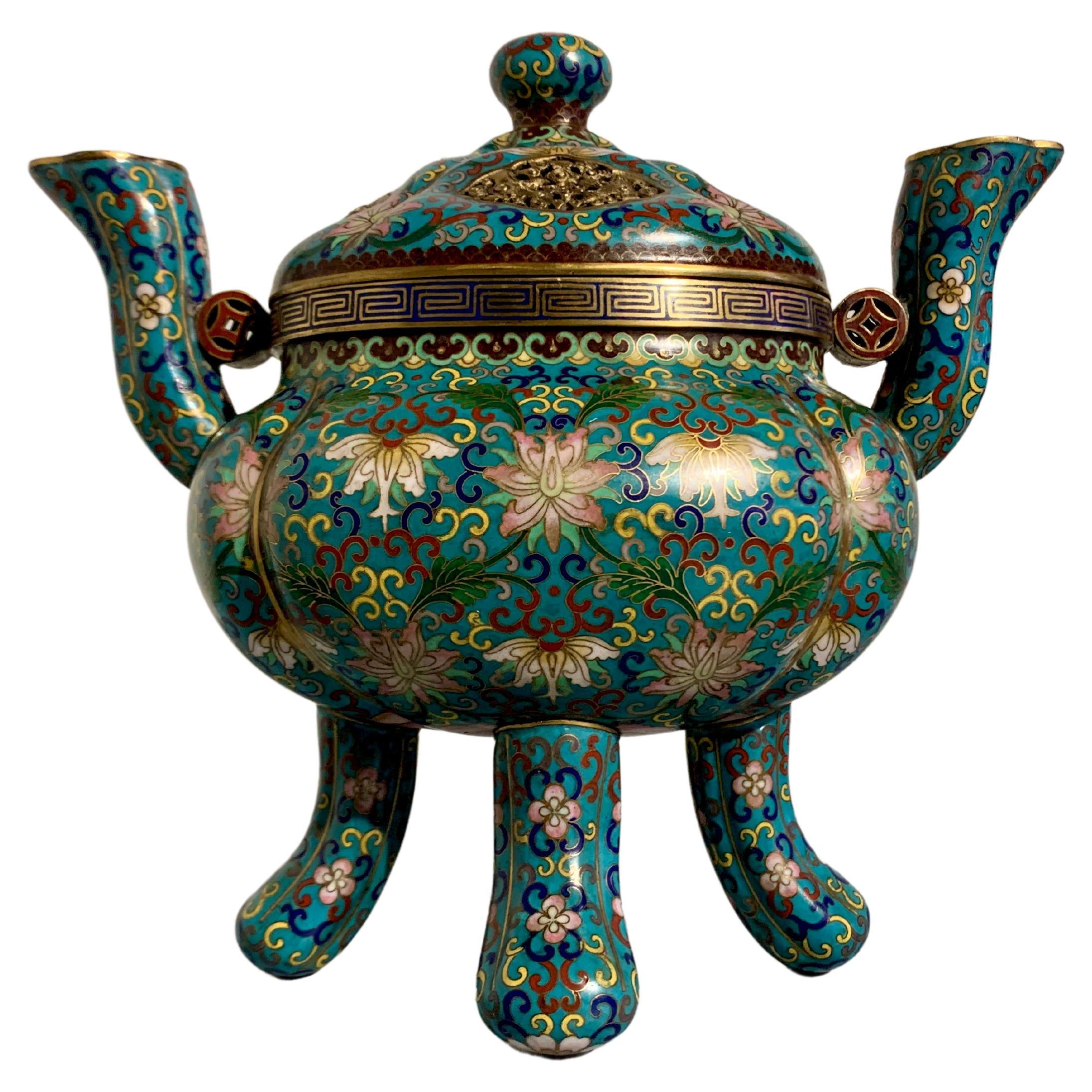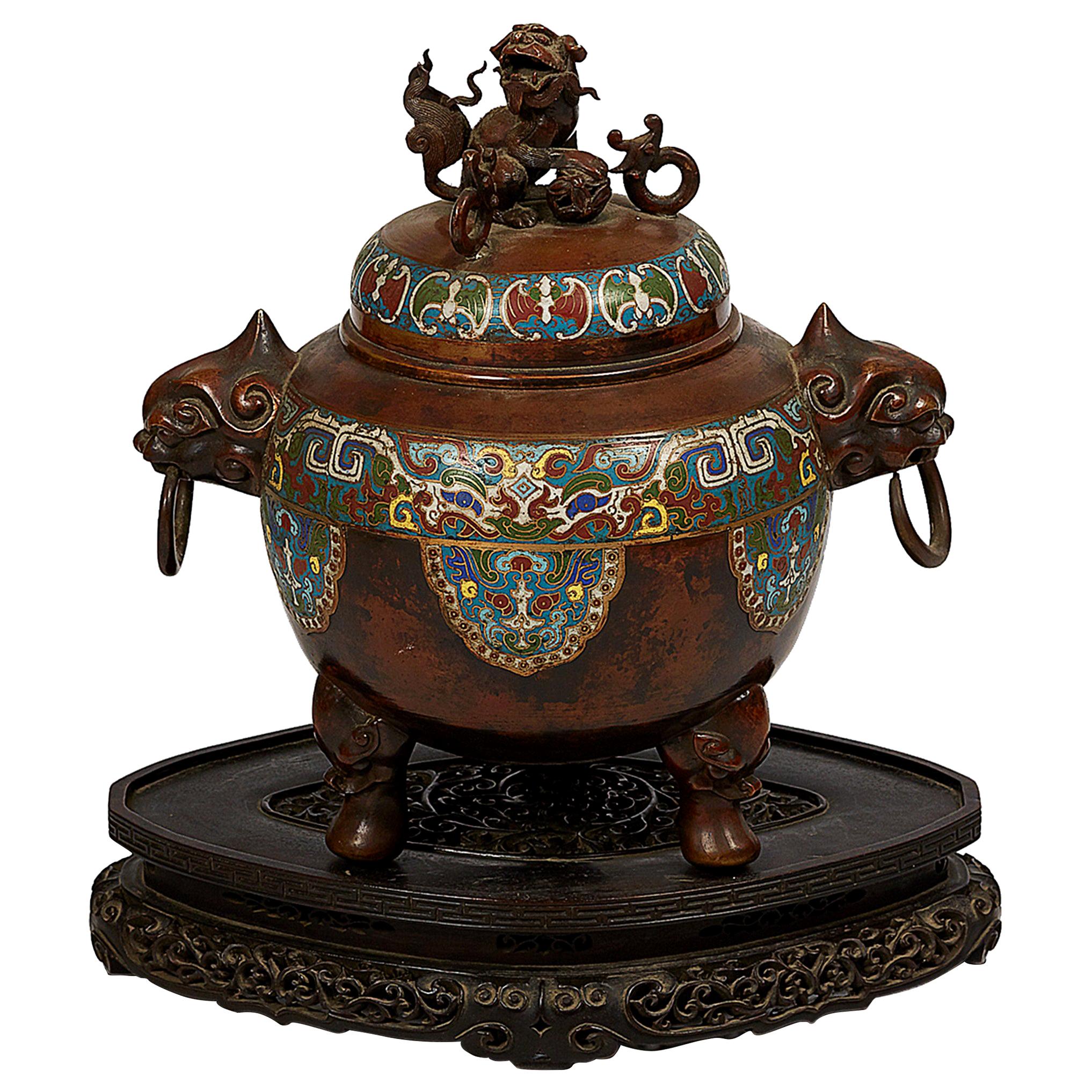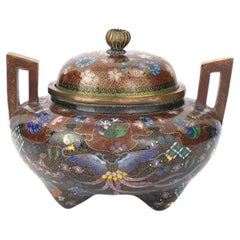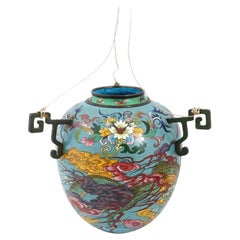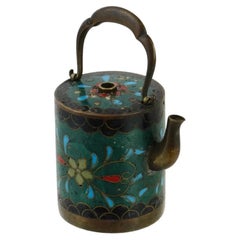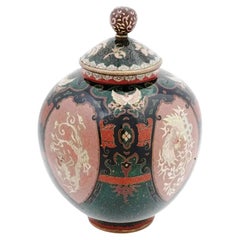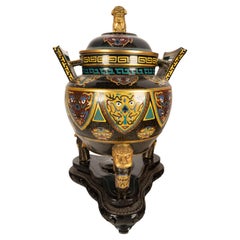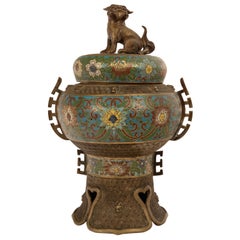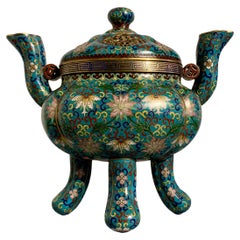Items Similar to Large Antique Japanese Cloisonne Enamel Censer Koro W Stand Attributed To GOTO
Want more images or videos?
Request additional images or videos from the seller
1 of 7
Large Antique Japanese Cloisonne Enamel Censer Koro W Stand Attributed To GOTO
$6,000
$12,00050% Off
£4,530.96
£9,061.9250% Off
€5,187.53
€10,375.0650% Off
CA$8,473.57
CA$16,947.1450% Off
A$9,251.11
A$18,502.2250% Off
CHF 4,849.98
CHF 9,699.9650% Off
MX$112,358.27
MX$224,716.5550% Off
NOK 60,568.32
NOK 121,136.6550% Off
SEK 57,192.65
SEK 114,385.3050% Off
DKK 38,719.40
DKK 77,438.8150% Off
About the Item
A large Japanese covered tripod enamel censer koro or incense burner. The sphere form ware is enameled with polychrome medallions representing cranes and birds in blossoming flowers made in the Cloisonne technique. The lid and the sides are adorned with polychrome medallions with Phoenix birds and animals surrounded by floral, foliage, bird and dragon motifs made in the same technique. The ware is adorned with a pair of curved handles and three legs made in the same design. The censer is adorned with a technique of using metal powders to give a glitter effect to the enamel. Completed with a carved wooden stand featuring a relief foliage design and pierced through accents. Unmarked. Antique and Vintage Asian and Oriental Enamel Wares, Desk Wares, Home Decor, and Collectibles.
Dimensions: 14 x 8 in. All measurements are approximate.
ConditionOverall good vintage condition. Signs of wear and age. hairline, Refer to photos
- Dimensions:Height: 14 in (35.56 cm)Diameter: 8 in (20.32 cm)
- Materials and Techniques:Enamel,Cloissoné
- Place of Origin:
- Period:
- Date of Manufacture:Late 19th Century
- Condition:Wear consistent with age and use. Minor losses. Good antique condition. Signs of age and wear. Refer to photos. Missing Finial.
- Seller Location:Long Island City, NY
- Reference Number:1stDibs: LU7386244157582
About the Seller
4.9
Platinum Seller
Premium sellers with a 4.7+ rating and 24-hour response times
1stDibs seller since 2022
103 sales on 1stDibs
Typical response time: <1 hour
- ShippingRetrieving quote...Shipping from: Long Island City, NY
- Return Policy
Authenticity Guarantee
In the unlikely event there’s an issue with an item’s authenticity, contact us within 1 year for a full refund. DetailsMoney-Back Guarantee
If your item is not as described, is damaged in transit, or does not arrive, contact us within 7 days for a full refund. Details24-Hour Cancellation
You have a 24-hour grace period in which to reconsider your purchase, with no questions asked.Vetted Professional Sellers
Our world-class sellers must adhere to strict standards for service and quality, maintaining the integrity of our listings.Price-Match Guarantee
If you find that a seller listed the same item for a lower price elsewhere, we’ll match it.Trusted Global Delivery
Our best-in-class carrier network provides specialized shipping options worldwide, including custom delivery.More From This Seller
View AllLarge Japanese Cloisonne Enamel Koro Incense Burner with Takara-Mono
Located in Long Island City, NY
A fine quality Japanese cloisonne covered koro or incense burner, Meiji era, 1868 to 1912. The piece features cloisonne handles and cover. The exterior is decorated with various desi...
Category
Antique Late 19th Century Japanese Meiji Metalwork
Materials
Enamel
Rare Large Japanese Cloisonne Enamel Green Dragon Oil Lamp
Located in Long Island City, NY
An antique Japanese Meiji period brass oil lamp. Features a vivid cloisonne enamel dragon motif set within a flower design, a distinctive characteristic of Japanese decorative arts during the era. The inclusion of three mounts for hanging suggests a functional and versatile design, allowing it to be suspended for ambient lighting. Circa the early 20th century. Antique Japanese Lamps...
Category
Early 20th Century Japanese Meiji Metalwork
Materials
Enamel, Brass
Rare Antique Japanese Meiji Cloisonne Enamel Water Dropper
Located in Long Island City, NY
An antique Japanese copper water dropper with cloisonne enamel design. Meiji period, 1868 to 1913. Cylinder shape, moveable top handle. Polychrome floral pattern against the dark gre...
Category
Antique Late 19th Century Japanese Meiji Metalwork
Materials
Copper, Enamel
$600 Sale Price
50% Off
Antique Japanese Cloisonne Meiji Goldstone Enamel Censer Koro with Dragons
Located in Long Island City, NY
An antique Japanese, late Meiji Era, lidded and footed enamel over brass censer koro or jar. Circa: late 19th century to early 20th century. The sphere form jar is enameled with meda...
Category
Antique Late 19th Century Japanese Meiji Jars
Materials
Enamel, Brass
Antique Japanese Cloisonne Enamel Vase W Bronze Dragons
Located in Long Island City, NY
An antique Japanese decorative cloisonne enamel vase with a gilt bronze base and handles. It has a rounded, bowl like shape of a blue color with floral and swirl patterns, adorned wi...
Category
Antique Late 19th Century Japanese Meiji Metalwork
Materials
Enamel, Bronze
Rare Japanese Red Birds Cloisonne Enamel Censer Koro
Located in Long Island City, NY
A rare antique Japanese late Meiji Era tripod and covered enamel copper censer. Circa: late 19th century to early 20th century. The sphere form censer koro is enameled with polychrom...
Category
Antique Late 19th Century Japanese Meiji Metalwork
Materials
Copper, Enamel
You May Also Like
Antique Chinese Qing Dynasty Cloisonne Censer Ding Lidded Incense Burner 1870
Located in Portland, OR
A fine antique 19th century Chinese cloisonne ding shaped lidded censer/incense burner on stand, circa 1870. The twin handled censer having a gilded foo dog finial to the lid, the li...
Category
Antique 1870s Chinese Qing Metalwork
Materials
Copper, Enamel
Vintage Chinese Cloisonne' Incense Burner - Censor - with Cover
Located in Bradenton, FL
Vintage Chinese cloisonné' enamel tripod incense burner and cover. Item is raised on three legs, each covered with lion mask. Beautiful lotus scroll in colors of rich blues, pinks, whites, and greens. Inside is solid turquoise...
Category
20th Century Chinese Chinese Export Metalwork
Materials
Enamel
Antique Chinese Qing Dynasty Bronze Cloisonne Enamel Censer Insence Burner 1900
Located in Portland, OR
A good, large, antique Chinese Qing dynasty bronze and cloisonne censer, circa 1900.
The lidded censer having a Chinese lion (Shi) to the lid, the...
Category
Antique Early 1900s Chinese Qing Metalwork
Materials
Bronze, Enamel
$1,000 Sale Price
20% Off
Chinese Cloisonne Incense Burner, circa 1960's, China
Located in Austin, TX
A fine and beautifully enameled Chinese cloisonne incense burner, censer, with pierced cover, mid 20th century, circa 1960's, China.
The ce...
Category
Vintage 1960s Chinese Qing Metalwork
Materials
Copper, Enamel
Japanese Meiji Period Bronze and Champlevé Enameled Censer
Located in Long Island City, NY
This Japanese censer incense burner, inspired by Chinese pieces, is of spheroidal form, the bronze body with polychrome champlevé enamel work flanked b...
Category
Antique Early 1900s Japanese Meiji Metalwork
Materials
Bronze
Large Chinese Cloisonné Tripod Incense Buner
Located in Norton, MA
Chinese Cloisonne Tripod incense holder having bronze of 3 elephant heads form the feet, dragon form handles on two sides and a big dragon head finial, alo...
Category
Antique 19th Century Chinese Chinese Export Metalwork
Materials
Copper
More Ways To Browse
Bird Dragon
Enamel Medallions
Polychrome Bird
Cloisonne Lidded
Cloisonne Stand
Oriental Desk
Japanned Tripod
Japanese Cloisonne Dragon And Phoenix
Dallah Arabic Coffee Pots
Dragon Tray
Islamic Brass Pot
Meiji Bronze Incense Burner
Middle Eastern Dallah Arabic Coffee Pot
Tibetan Repousse
Asian Gong
Brass Arabic Coffee Pot
Chinese Hand Warmer
Cloisonne Tray
